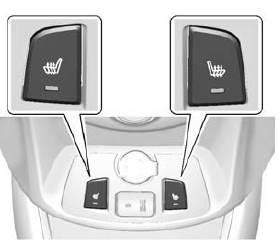Chevrolet Spark Owners Manual: Heated Front Seats
Warning
If you cannot feel temperature change or pain to the skin, the seat heater may cause burns. To reduce the risk of burns, people with such a condition should use care when using the seat heater, especially for long periods of time. Do not place anything on the seat that insulates against heat, such as a blanket, cushion, cover, or similar item. This may cause the seat heater to overheat. An overheated seat heater may cause a burn or may damage the seat.

If available, the buttons are below the climate control system. To operate, the engine must be running.
Press  or
or
 to heat the driver or passenger seat.
to heat the driver or passenger seat.
The indicator light on the control turns on when this feature is on. Press the control
again to turn this feature off.
The passenger seat may take longer to heat up.
 Front Seat Armrest
Front Seat Armrest
There is an armrest on the inboard side of the driver seat. To raise or lower
the armrest, push up or pull down on the armrest. ...
 Rear Seats
Rear Seats
Folding the Seatback
Either side of the seatback can be folded down for more cargo space.
Fold a seatback only when the vehicle is not moving.
Caution
Folding a rear seat with the safety belts sti ...
Other materials:
System Settings
Configuring the Number of Favorite Pages
Up to six favorite pages can be saved, and each page can store up to six radio
stations.
To configure the number of available favorite pages:
Press the CONFIG button.
Select Radio Settings.
Select Radio Favorites.
Select the number of available ...
Traction Control System (TCS)/StabiliTrak Light
The StabiliTrak or Traction Control
System (TCS) indicator/warning light comes on briefly when the engine is started.
If the light does not come on, have the vehicle serviced by your dealer.
If the system is working normally, the indicator light turns off.
If the light is on and not flashing, ...
Leaving the Vehicle with the Engine Running (Automatic Transmission)
Warning
It can be dangerous to leave the vehicle with the engine running.
It could overheat and catch fire.
It is dangerous to get out of the vehicle if the shift lever is
not fully in P (Park) with the parking brake firmly set. The vehicle can roll.
Do not leave the vehicle when the engine is ...
